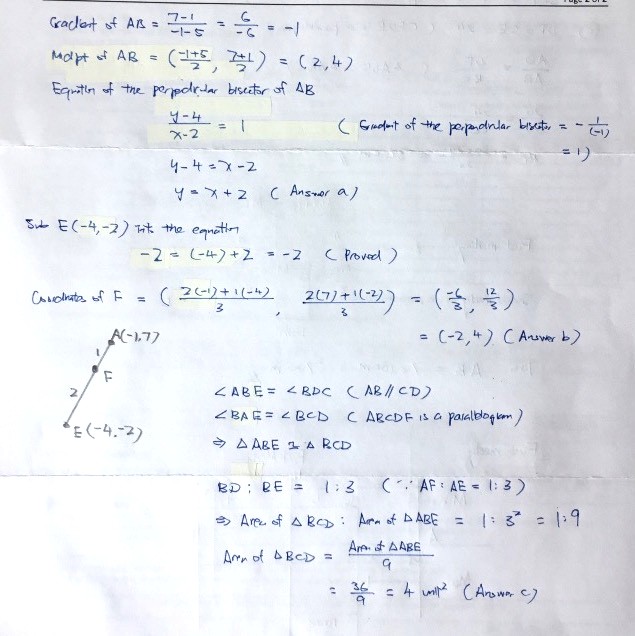Ask Singapore Homework?
Upload a photo of a Singapore homework and someone will email you the solution for free.

Question
secondary 3 | A Maths
One Answer Below
Anyone can contribute an answer, even non-tutors.

I can’t solve someone please help!!
In particular, the perpendicular bisector of AB is a line which meets AB at right angles and passes through the mid-point of AB.
As you have probably learnt by now, the product of the gradients of two perpendicular lines is equal to -1.
To find the equation of this perpendicular bisector (which is equivalent to finding the equation of a straight line), we need to
- find the gradient of this bisector and
- find the midpoint of AB.
The gradient of AB
= change in y / change in x
= [1 - 7] / [5 - (-1)]
= -6 / 6
= -1
Since gradient AB x gradient bisector = -1, the gradient of the bisector must be 1.
The midpoint of AB
= (average of x, average of y)
= [(-1 + 5)/2, (1 + 7)/2]
= (2, 4)
Now that we have the gradient of the line (1) and a point on the line (2, 4), we are ready to form the equation of the line (i.e. the bisector).
y = mx + c
y = x + c (since m = 1)
Substituting (2, 4) into the equation,
4 = 2 + c
2 = c
So, the equation of the perpendicular bisector must be y = x + 2.
To check that the line passes through E (-4, -2), we simply check that the x- and y- coordinates of E satisfy the equation.
Clearly -4 + 2 = -2, so this is satisfied and E must lie along the line. Therefore, the line passes through E.
- 3 units to the right (from -4 to -1)
- 9 units upwards (from -2 to 7)
Since AF : FE = 2, it is clear that EF : EA = 2 : 3, so the movements of E to F will be 2/3 of the movements of E to A.
E to F is a direct movement of
- 2 units to the right
- 6 units upwards
So, the coordinates of F
= (x-co. of E + 2, y-co. of E + 6)
= (-4 + 2, -2 + 6)
= (-2, 4)
Another way to do this is to find the coordinates of D and then perform the Gaussian Area Formula (i.e. the "shoelace" method), but this is much trickier.
I will not do this part on the assumption that you have yet to learn similar triangles.
If you recall in Sec 2 Maths, for any two similar triangles, their corresponding length ratios are the same.
[The concepts in Sec 2 are the basic ones which assume that the triangles or other shapes are already congruent or similar, while the concepts in Sec 3 aim to prove the congruency/simililarity rather than assume them]
We see that AF : FE = 1 : 2, so needless to say, AE : FE = 3 : 2.
Triangles ABE and FDE are obviously similar (this is normally what happens when lines such as AB and FD are parallel).
[I assume you have recently learned to write the proof for similarity, correct?]
In such situations, the other corresponding ratios such as AB : FD or BE : DE would also be 3 : 2 as a result.
We do not exactly need to find the coordinate of D in solving this part. However, if you wish to find the coordinates of D, we use the fact that BE : DE is equal to 3 : 2.
BE : DE = 3 : 2
EB : ED = 3 : 2
Note that E and B have coordinates (-4, -2) and (5, 1) respectively.
So, E to B is a movement
==> 9 units to the right
==> 3 units upwards
E to D is a movement which is 2/3 of this (that's what the ratio 3 : 2 is all about!)
So, E to D is a movement
==> 6 units to the right
==> 2 units upwards
So, we can see that the coordinates of D
= (-4 + 6, -2 + 2)
= (2, 0)
Yes, I know that D does not appear to be on the x-axis, but I know that some diagrams are misleading. In the actual O Levels, the diagrams are usually accurate to the scale.
When two triangles are similar, their area ratio would be the square of their length ratio.
[This is because areas are two-dimensional figures; the bases are in a ratio and the heights are in the same ratio, so collectively the area ratio takes these two identical ratios into account]
Recall that length ratio EF : EA = 2 : 3.
Correspondingly, area ratio FDE : ABE = 2² : 3² = 4 : 9.
We can use this ratio 4 : 9 for area comparisons. Since the area of ABE is 36 units², the area of FDE would be 16 units².
Now, the challenge would be to find the area of triangle BCD.
I will outline this next.
[Hint: Lines EF and BC are parallel since they are sides of a parallelogram]
Their length ratio would be the ratio of their corresponding lengths, say FE : CB.
But obviously CB = FA because their sides of a parallelogram!
We know very well that EF : EA = 2 : 3 from our previous workings, so FE : FA = 2 : 1 and therefore FE : CB = 2 : 1.
With this, we see that the area ratio FDE : CDB = 2² : 1² = 4 : 1.
Since the area of FDE is 16 units², the area of CDB must be 4 units².
Therefore, the area of triangle BCD is 4 units².
See 1 Answer





